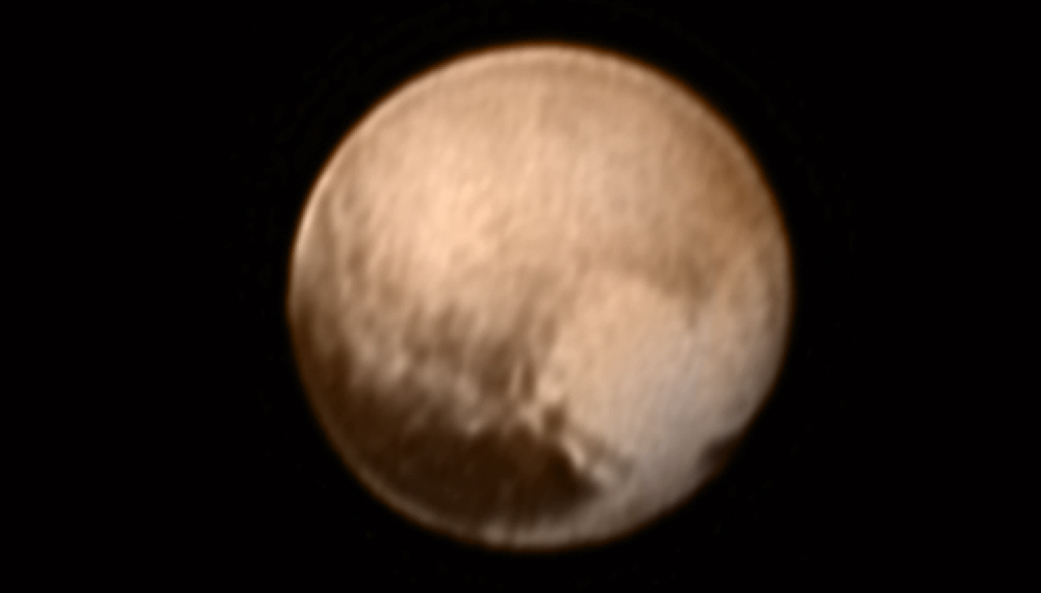
NASA's New Horizons probe captured amazing images of Pluto, scientists revealed details about a proposed superpowerful space telescope and NASA announced its first four commercial-crew astronauts. Here are Space.com's top stories of the week.
Best looks yet at Pluto and Charon
New images taken Wednesday (July 8) by NASA's New Horizons probe show that Pluto and Charon are very different bodies, though they circle a common center of gravity and are separated by a mere 12,200 miles (19,640 kilometers). [Full Story: Pluto 'Totally Different' from Big Moon Charon, New Photos Show]
Seeing Pluto's 'heart'
Pluto looks especially welcoming in a new photo taken on July 7 by NASA's approaching New Horizons probe. The image shows a large, heart-shaped feature on the dwarf planet's surface. [Full Story: Pluto's 'Heart' Spied by New Horizons Spacecraft (Photo)]
Shooting stars on demand
A group of Japanese scientists say they have a shooting-star secret formula — an undisclosed chemical mixture packed into tiny, inch-wide balls that the team hopes to eject from a satellite to create on-demand meteor showers. [Full Story: Company Aims to Offer On-Demand Meteor Showers]
Get the Space.com Newsletter
Breaking space news, the latest updates on rocket launches, skywatching events and more!
Wheel damage a concern for Mars rover Curiosity
NASA's Mars rover Curiosity faces ongoing wheel wear and tear as it continues its trek across the rock-strewn Red Planet. [Full Story: Wheel Worries: Mars Rover Curiosity Dealing With Damage]
Could Mars life be supported by atmospheric moisture?
Mars may appear to be dry and desolate, but the Red Planet can be surprisingly humid — perhaps humid enough to support life, some scientists say. [Full Story: Is Mars Humid Enough to Support Life?]
A new look at Saturn moon Enceladus' interior
Eruptions of vapor and ice that stretch for miles above the surface of Saturn's icy moon Enceladus experience a mysterious delay that could be due to a weak interior, new research suggests. [Full Story: What's Inside Saturn Moon Enceladus? Geyser Timing Gives Hints]
A space telescope 25 times sharper than Hubble?
The proposed High Definition Space Telescope would have 25 times the resolution of Hubble and would serve as a "flagship observatory" for the global astronomical community. One of its main objectives would be to study the atmospheres of dozens of Earth-like alien planets, looking for signs of life. [Full Story: Powerful Space Telescope Would Scan Alien Planets for Signs of Life]
Neptune's crazy magnetic field
Researchers reconstructed Neptune's odd magnetic field by combining data gathered by NASA's Voyager 2 probe in 1989 with a new model that was originally built to describe how plasma acts in the lab. The new results paint a picture of a field continuously in flux, tilted and bubbling out to one side. [Full Story: Neptune's Strange Magnetic Field Stretches Arms in New Model (Video)]
Dawn staying put at Ceres while glitch investigation continues
NASA's Dawn probe is staying in its current orbit around the dwarf planet Ceres a bit longer than originally planned while engineers try to figure out why the probe went into a precautionary "safe mode" late last month. [Full Story: Dawn Spacecraft in Holding Pattern at Ceres After Glitch]
Magnetar may have sparked huge gamma-ray burst
One of the most powerful cosmic explosions ever observed by astronomers may have been powered by a massive, incredibly strong magnetic object, new research suggests. [Full Story: Massive 'Magnet' May Have Powered Monster Cosmic Explosion]
Ancient planets offer alien life lots of time to evolve
Scientists have discovered a number of alien solar systems much older than our own. If any such ancient worlds host life, it would have had a long time to evolve. [Full Story: Ancient Exoplanets Raise Prospects of Intelligent Alien Life]
NASA names 1st four astronauts to ride private space taxis
NASA has named its first commercial crew "cadre" — four astronauts who will train to fly on board the first test flights of Boeing's CST-100 capsule and SpaceX's Dragon spacecraft. [Full Story: NASA Assigns 4 Astronauts to Commercial Boeing, SpaceX Test Flights]
Supermassive black hole's growth defies expectation
A newfound giant black hole nearly as massive as 7 billion suns is dozens of times larger than astronomers expected given its host galaxy's size, researchers say. [Full Story: Enormous Black Hole Is Too Big for Its Galaxy]
The link between Pluto and Luke Skywalker's home planet
In recent years, planetary scientists have begun to suggest that Pluto and its moons might serve as an analogue to planets orbiting double star systems — like the fictional planet Tatooine, home of Luke Skywalker. [Full Story: What Pluto Can Teach Scientists About 'Star Wars' Planet Tatooine]
Follow Mike Wall on Twitter @michaeldwall and Google+. Follow us @Spacedotcom, Facebook or Google+.
Join our Space Forums to keep talking space on the latest missions, night sky and more! And if you have a news tip, correction or comment, let us know at: community@space.com.

Michael Wall is a Senior Space Writer with Space.com and joined the team in 2010. He primarily covers exoplanets, spaceflight and military space, but has been known to dabble in the space art beat. His book about the search for alien life, "Out There," was published on Nov. 13, 2018. Before becoming a science writer, Michael worked as a herpetologist and wildlife biologist. He has a Ph.D. in evolutionary biology from the University of Sydney, Australia, a bachelor's degree from the University of Arizona, and a graduate certificate in science writing from the University of California, Santa Cruz. To find out what his latest project is, you can follow Michael on Twitter.









